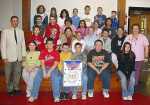Sheldon fifth and sixth grade students create Olympic Village

Since the start of the 2006 Winter Olympics, the world has turned its eyes towards Torino, Italy. However, this year, the Olympics games were brought close to home for Sheldon students.
Sara Ewing's sixth grade class worked in collaboration with Charles Townsend's fifth grade class to form what they call their "Olympic Village."
The students have worked hard researching, learning and teaching others not only about the present Winter Olympics, but about the history of the ancient Olympics as well.
Ewing developed the interactive idea that led her to this expansive project.
Ewing said she asked herself what would get kids interested in other countries and cultures -- and the Olympics seemed to be the answer.
Inside the Olympic VIllage, the hallway is filled with historical briefs on the winter games -- games such as shuffleboard, snowboarding, figure skating (ice dancing) and even the biathlon.
Looking at the expanse of information, Ewing said, "It's been a lot of work, but it's been fun."
The children also collaborated with one another throughout the project and were required to pick a top athlete from each sports category. For instance, from boxing they picked Cassius Clay and George Foreman. Each student researched a sport to keep an eye on the Winter Olympic games, everything from shuffleboard to the biathlon. In the Olympic Village, the students set up a "Greek Corner," where they researched the ancient Olympics and wrote their names in Greek, as well as studying Alexander the Great, Mount Vesuvius and Pompeii.
Ewing said that there are lots of teaching tools relating to the project. The students also set up a flag lotto, which involved a bingo type activity while utilizing the flags of Europe. Students will be keep this Olympic Village in place until March. The village is a cooperative learning effort, that involved the entire elementary school from pre-kindergarten to fourth grade. The students not only utilize math skills by constructing bar graphs but they also are researching the social sciences.
For example, Townsend's fifth grade class featured the Olympic rings. Students were to stand within them and give a speech about a certain country and the games. The fifth and sixth grade classroom really enjoyed this project, teachers noted.
"We have had a lot of fun with this. They have books for teachers available as well. The kids have done really well with it," Ewing said.
Cody Seibert, a sixth grade student in Ewing's class, said, "It was fun, we learned about freestyle skiing and snowboarding."
The students learned that the five Olympic rings were actually discovered by archeologists.
The archeologists had found them engraved on an altar that was uncovered during the excavation at Delphi, Greece. It has been suggested that they were used as a symbol of the Olympic games, with the rings on either side representing the year of the games and the three in between representing the years in between. Baron de Coubertin, who helped initiate the modern games used these rings to symbolize the five continents of the world. These include North and South America (counted as one), Europe, Asia, Africa, and Australia. He chose the colors blue, yellow, black, green, and red because the flag of each competing nation has at least one these colors. The colored rings placed on a background of white became the design for the Olympic Games in Antwerp, Belgium, in 1920. Since then it has been raised at the Opening Ceremonies of each successive Olympic Games.
Katie McGraw, a sixth grade student, said, "I think it's really cool that we got to do it this year. It's really cool to have a fun teacher this year. My favorite sport was figure skating."
The fourth grade class enjoyed themselves at the Olympic Village, Marsha Denton the fourth grade teacher said "It was really interesting. Kids really liked the volcano, and they also liked the dog." The sixth graders also presented Greek Myths to the fourth graders and really involved them in this project.
Cole Worslet said "I think it was fun, really educational and fun for the little kids. We wrote peoples names in Greek. My favorite game is bobsledding."
